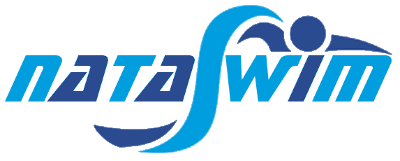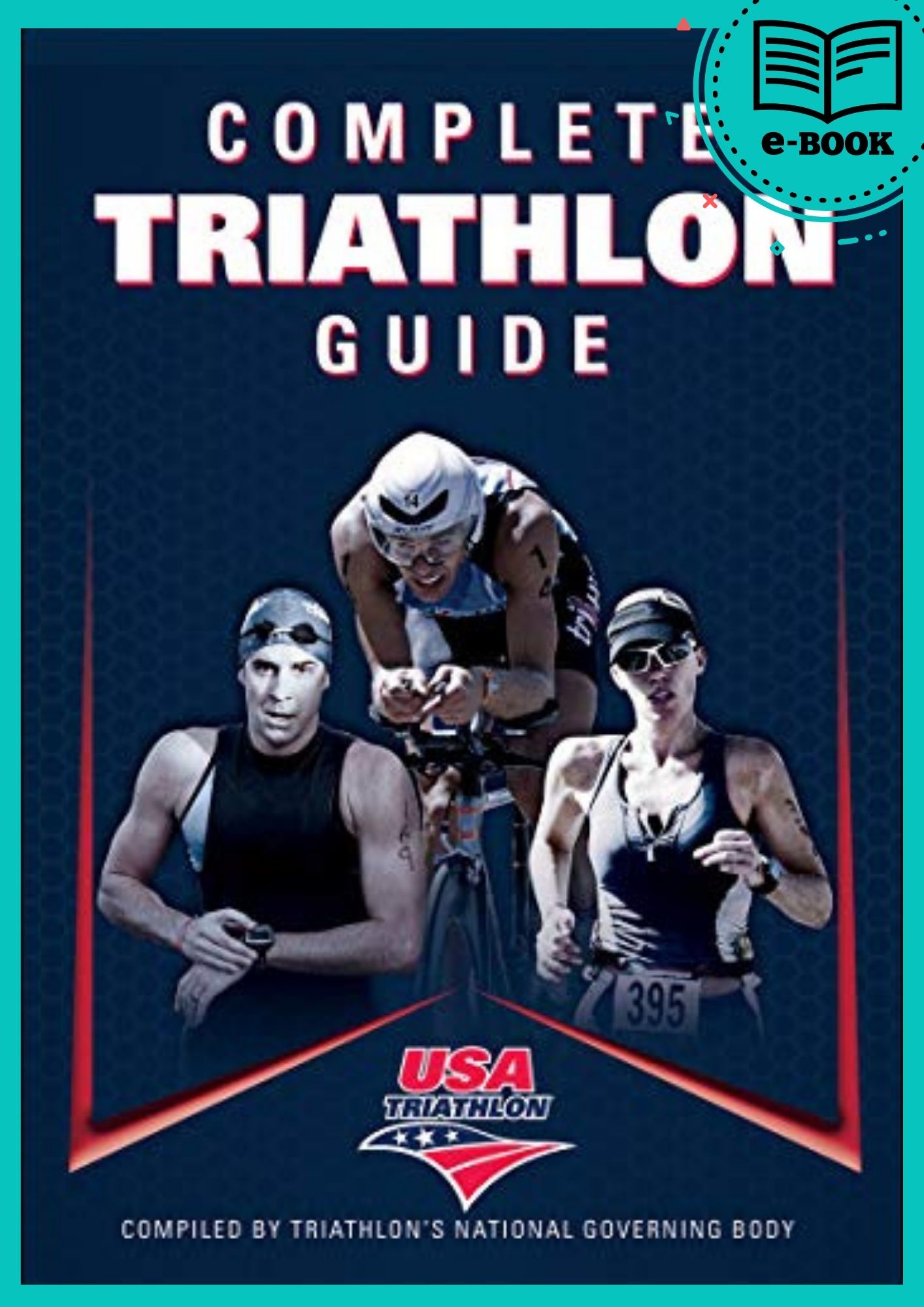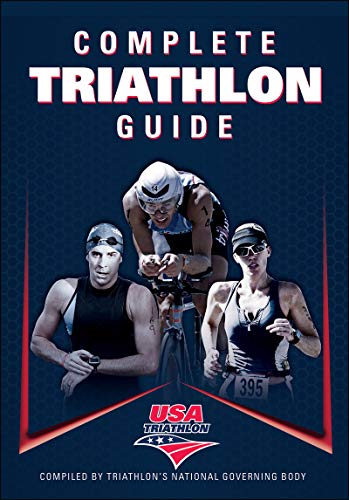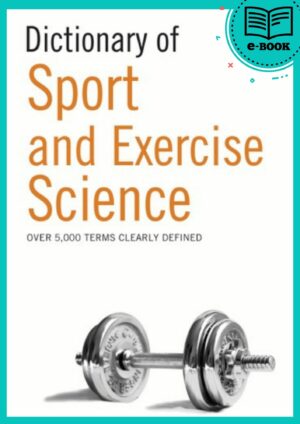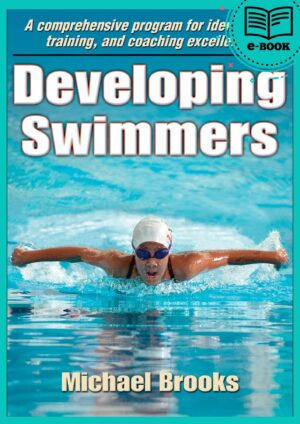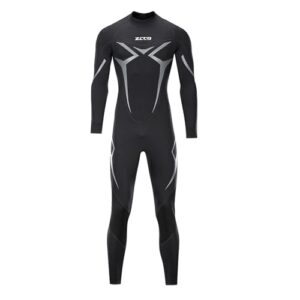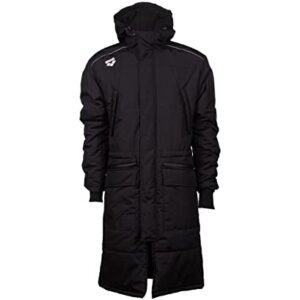Complete Triathlon Guide
Triathletes, rejoice! For the first time, USA Triathlon, its elite athletes, and the nation’s most respected coaches share their secrets, strategies, and advice for every stage, every event, and every aspect of the world’s most demanding sport. From training to technique, fueling to recovery, if it’s essential to the sport, it is covered in Complete Triathlon Guide. In this guide, you’ll find invaluable bike-handling techniques straight from the pros, learn how to assess running form and improve running cadence and stride, troubleshoot your freestyle swim stroke, and shave seconds off starts and transitions.
200 en stock
€ 9.00

Part I Training
Chapter 1 Developing Your Seasonal Training Plan
Chapter 2 Customizing Training for Specific Groups
Chapter 3 Yoga and Flexibility for Triathletes
Chapter 4 Strength Training for Triathletes
Chapter 5 Training for Triathlon Swimming
Chapter 6 Training for Triathlon Biking
Chapter 7 Training for Triathlon Running
Chapter 8 Recovery and Overtraining
Chapter 9 Exercise Physiology for Triathletes
Chapter 10 The Art and Science of Tapering
Part II Technique
Chapter 11 Bike Handling Techniques from the Pros
Chapter 12 Setting the Perfect Cadence and Stride Rate
Chapter 13 Assessing Your Running Form
Chapter 14 Improving Your Transitions
Chapter 15 Troubleshooting Your Freestyle
Part III Competitive Strategy
Chapter 16 Open Water Race Tactics
Chapter 17 Strategies for Drafting and Non-Drafting Races
Chapter 18 Performance Tips for Any Distance
Chapter 19 Mental Strategies for Training and Racing
Chapter 20 Traveling for Competition
Part IV The Triathlon Lifestyle
Chapter 21 Fitting Triathlon into Busy Lives
Chapter 22 Choosing the Ideal Gear
Chapter 23 Choosing a Coach
Chapter 24 Developing Young Triathletes
Chapter 25 Dealing with Common Injuries
Chapter 26 Nutrition for the Endurance Athlete
Chapter 27 Hydrating During Training and Competition
Chapter 28 Beyond Swim, Bike, Run
Chapter 29 Long-Term Triathlete Development
And you’ll go inside the sport for expert instruction and personal insights from triathlon’s biggest names:
Joe Friel
Gordon Byrn
Bob Seebohar
Sage Rountree
Ian Murray
Sara McLarty
Linda Cleveland
George Dallam
Steve Tarpinian
Krista Austin
Iñigo Mujika
Alicia Kendig
Barb Lindquist
Christine Palmquist
Graham Wilson
Jackie Dowdeswell
Jess Manning
Joe Umphenour
Karl Riecken
Katie Baker
Kristen Dieffenbach
Kurt Perham
Mathew Wilson
Michael Kellmann
Mike Ricci
Scott Schnitzspahn
Sergio Borges
Sharone Aharon
Suzanne M. Atkinson
Timothy Carlson
Yann Le Meur
With Complete Triathlon Guide you’ll enhance your training regimen with the most effective workouts, including stage-specific programs for swimming, cycling, and running; programs for strength, flexibility, and endurance; tactics that address individual weaknesses; and advice on tapering to ensure you’re in peak physical condition on race day.
INTRODUCTION
Welcome to Complete Triathlon Guide. The sport of triathlon is growing at a tremendous rate as more and more people participate in triathlons to stay healthy, get fit, and have fun. Triathletes are highly motivated, and they want to learn everything they can about the sport to help themselves become better athletes. Training for triathlons is a challenge because of the unique balance needed in swimming, biking, and running in order to achieve success. This book provides athletes and coaches of all skill and experience levels the best training information and racing strategies available. It is an absolute must-have resource for coaches and athletes who are serious about taking performance to the next level or those wanting to learn more about the sport. Complete Triathlon Guide is filled with training tips and information from the best-known experts in the triathlon field.
When we started discussing the possibility of putting this book together, we were excited to have the leaders of triathlon coaching, training, and racing willing to write a chapter on a topic they are best known for. Each of these authors has enough knowledge and expertise to write their own books, and many have, so we are grateful to each of them for sharing a piece of their knowledge in this book.
Part I, Training, includes chapters 1 through 10. Chapter 1 focuses on developing your seasonal training plan and understanding periodization. Chapter 2 discusses how to customize training for special groups including beginners, youth, and masters and female athletes. Chapter 3 introduces you to yoga by talking about the benefits of yoga and types of classes while also providing several yoga poses that can be practiced at home. Chapter 4 helps you understand how to incorporate strength training for triathletes by covering resistance training concepts, organizing a strength training program for triathlon, and explaining specific strength training exercises that can improve a triathlete’s fitness and performance.
As we move into chapter 5, we start getting into sport-specific training by covering swimming pool workouts for open water including the warm-up, technique work, main set, and cool-down. Chapter 6 discusses training for triathlon biking, while chapter 7 gets into the specifics of triathlon run training. Chapter 8 is dedicated to helping you understand overtraining and recovery, how to balance stress and recovery, and how to anticipate and prevent overtraining. Chapter 9 sets the foundation for the book as it discusses exercise physiology, covering the energy, muscular, and cardiorespiratory systems, and shows how manipulating the training loads affects physiological adaptations. Chapter 10 will teach you several key points about tapering including managing the training load during the taper, enhancing recovery during the taper, managing nutrition and hydration during the taper, and other details related to tapering.
Part II, Technique, includes chapters 11 through 15. Chapter 11 discusses bike fitting and mounting, essential skills for the road, and race-day skills. Chapter 12 covers how to set, improve, manage, maintain, and train your bike and run cadences. Chapter 13 goes over the key concepts of how to assess your running form including head, neck, and eye position; breathing; and head-to-toe body position. Chapter 14 explains the importance of setting up your transitions correctly, how to move from the swim to the bike and the bike to the run quickly, and how to have a great swim start. Chapter 15 focuses on how to reduce drag and create propulsion in the water by using body position and an efficient swim stroke.
Part III, Competitive Strategy, includes chapters 16 through 20. Chapter 16 covers everything you need to know about open-water training, tactical race aspects, rules, prerace warm-up, and specific swim tactics. Chapter 17 helps you understand the differences between cycling in a nondrafting race versus a drafting race as well as the skills used in each. Chapter 18 discusses how important it is to understand your limits when it comes to training and racing for triathlons as well as how to strengthen your weaknesses, increase your strengths, and individualize your training. Chapter 19 focuses on getting you mentally prepared for race day by evaluating your mental skills, describing mental skills strategies, and teaching you how to practice mental skills. Chapter 20 helps you prepare for traveling to a race by teaching you how to pack your bike and race gear, how to travel comfortably, and how to arrive at your destination relaxed and ready to race.
Part IV, The Triathlon Lifestyle, includes chapters 21 through 29. Chapter 21 provides you with strategies to help you fit training into your daily schedule while balancing your work and personal life by using time management skills and building a support network. Chapter 22 is a comprehensive discussion of the technological milestones that have been key to triathlon development and how to choose the best swim, bike, and run gear to match your skill level. Chapter 23 discusses what qualities you should look for in a coach, from education and background to philosophy and programs, as well as how a coach can help you with physical and mental skills, fitness assessments, and testing and time management.
Chapter 24 is dedicated to helping you promote an athletic childhood for the children in your life, how to get kids started in triathlon, and how to create champions of sport and life. Chapter 25 covers the most common injuries seen in triathletes, including specific swimming, cycling, and running injuries, and how to treat injuries and when to seek a medical professional’s advice. Chapter 26 explains how to use the nutrition periodization concept and how to eat based on your physical activity and what phase of training you are in. Chapter 27 discusses the physiological role of water and hydration and the specific fluid needs for athletes before, during, and after training and competition. This chapter also covers the adverse health effects related to hydration. Chapter 28 covers other multisport activities beyond just triathlon including duathlon, off-road triathlon, winter triathlon, and adventure racing. Chapter 29 covers how to assess your athletic range and depth of fitness and how to be a lifelong triathlete through safe and effective training.
Developing Your Seasonal Training Plan
Just like any project we do in life, whether it’s to plan a trip, build a tree house, or start a business, careful planning will be a critical step and most likely will make the difference between success and failure. Athletic performance, and in this case, triathlon training, is no different. Developing a training plan is a crucial step in maximizing performance for every athlete. Doing it well will help you identify clear goals, understand your current level of readiness, and establish an accurate training regimen. The annual plan should be your training road map. It should be the instrument that guides training and facilitates improvement in technical, physiological, and psychological abilities. Planning is by far the most important tool you have regardless of your level of knowledge and experience. The planning process requires you to take a realistic look at your current position on a frequent basis throughout the season. It requires you to acquire new information and then make decisions on how you are going to train.
The objective of every training program is to ensure peak performance on a specific date. This is a challenging task that is often hard to achieve. For example, insufficient rest in the training plan will most likely cause the athlete to reach peak performance before the desired race date. On the other hand, not enough training will most likely result in peak performance after the desired race date. Knowledge, a methodical approach, and experience are the key factors in building that plan. Poor planning will lead to an inaccurate peak performance and a decrease in motivation, and it can dramatically increase the chances for injury and overtraining.
Periodization is the gold standard of developing an annual training plan. Knowing your goals and understanding your current level of fitness make up the first step of a successful plan. Although the concept of periodization and the development of a yearly plan vary a bit from one sport to another and even between coaches within a sport, the basics are still the same. I will try to convey them to you in this chapter.
Understanding Periodization
The term periodization comes from period and means dividing a certain amount of time, in this case the training year, into smaller, easier-to-manage phases. The periodization concept is not new and was used in many forms as far back as the ancient Olympic Games. Many coaches, in a variety of sports, use the periodization concept, although the names, number, and length of phases in the plans might be slightly different. The most common periodization refers to three segments of time that repeat themselves and differ by size: macrocycle, mesocycle, and microcycle.
Macrocycle
The macrocycle is a long stretch of training that focuses on accomplishing a major and important overall goal or a race. For example, if the Chicago Triathlon is your most important race of the season, the time from the first day of training at the beginning of the season until that race will be what you consider your macrocycle. A macrocycle is then made up of a number of different small- and medium-size phases and covers a period of a few weeks to 11 months.
For most athletes, and especially beginners, a macrocycle covers the entire racing season, focusing on one big race for the year and the development of basic physical and technical skills. More advanced and elite athletes will have two or three macrocycles per racing season; elite athletes race multiple important races per season because they may need to accumulate points or qualify for the championship race. The number of macrocycles mostly depends on the number of times these athletes need to reach peak performance within a given racing season. Elite athletes preparing for Olympic competition often use macrocycles to represent a 4-year cycle, planning different or progressive goals for each of the 4 years.
Mesocycle
The mesocycle can be a confusing concept, as its definition might be different from one coach to another. In general, the mesocycle is a shorter block of training within the macrocycle that focuses on achieving a particular goal. A mesocycle usually covers 3 to 16 weeks and will repeat a few times within a macrocycle, each time with a different training objective or goal. There are three mesocycles, or phases, that coaches often use within the annual training plan: preparatory, competitive, and transition. These phases can be (and most of the time are) divided into smaller, more specific subphases because of the different training objectives for each.
The preparatory phase is the period that establishes the physical, technical, and psychological base from which the next phase, the competitive phase, is developed. The preparatory phase is divided into general and specific preparation subphases. The general preparatory subphase focuses on developing high-level conditioning to tolerate the demands of both training and competition. The specific preparatory subphase also has the objective of elevating athletic working capacity specific to the demands of your race. Some coaches call these subphases “prep” and “build.” The next phase, the competitive phase, is divided into precompetitive and competitive subphases. The objective of this phase is to perfect all training factors to ensure successful racing. The precompetitive subphase uses racing to test your ability. It’s an objective feedback for your training and level of preparation. The competitive subphase is dedicated to maximizing your fitness for maximum performance. Finally, the third phase, called the transition phase, is the rest and rejuvenation phase in between training cycles or seasons.
The size of each mesocycle, or phase, is different and is mostly related to the training objective for that particular phase of training and its position within the race schedule. In the preparatory phase, the objective is to develop technique, endurance, and an overall conditioning foundation. These elements take a long time to develop, and therefore the preparatory phase will be the longest phase of your annual training plan. The competitive phase is shorter as the focus is on racing, which is very stressful, and therefore the amount of time you can be in that phase without detrimental effect on your body is limited. You will learn more about how to build the training phases in the section on dividing your season into training periods later in this chapter.
Keep in mind that the level of the athlete will also influence the length of each phase. For example, a beginner athlete most likely will have a very long preparatory phase, up to 22 weeks, if needed, to develop a strong foundation that will enable him to endure the load of progressive, more advanced training. On the other hand, an advanced athlete who has been training for a few years has already developed a strong foundation and may need only 12 to 16 weeks to get there, and therefore she can move to the competitive phase of training more quickly.
Microcycle
A microcycle is the basic training phase that repeats itself within the annual plan. The microcycle is the smallest training period within the annual training plan, and it is structured according to the objectives, volume, and intensity of each mesocycle. The microcycle is probably the most important and functional unit of training, as its structure and content determine the quality of the training process. A microcycle can last for 3 to 10 days, but in most cases, it refers to the weekly training schedule. The progression of the microcycles within a mesocycle has to take into consideration the important balance between work and rest. Too much work without appropriate rest will lead to overtraining and injuries. On the other hand, too little work with too much rest will lead to underperformance. The common ratios of work to rest in a microcycle are 3:1 or 2:1; however, in some extreme cases of heavy-load weeks (the combined stress produced by volume and intensity on the body), a 1:1 work-to-rest ratio is used. Work-to-rest cycles are called training blocks.
You should first plan each microcycle, rather than plan individual workouts, and start by taking into consideration the physiological adaptation you are looking for during a particular training phase. For example, in the preparatory phase, your microcycles will be focused on developing endurance; therefore the key workouts of those weeks should be long and of endurance-promoting intensity. In the competitive phase, your objective is to develop speed; therefore your workouts will be shorter in nature and at a much higher intensity. Thus, make sure the order of the training sessions within the week promotes the desired training effect for the week and is relevant to the training objective. In the preparatory phase, you should plan short, high-intensity workouts before long, steady-state workouts, with a recovery day between these days. However, during the precompetitive phase, you may change the weekly schedule a bit; instead of having a recovery day between two hard days, plan the week with a high-intensity day followed by a long-endurance day, and then schedule a recovery day. Doing so increases the physiological and psychological stress on the body and develops a higher level of fitness that is appropriate for this period in the annual plan. You’ll learn more about how to plan your weekly schedule later in this chapter.
The structure of the microcycle should also be based on training principles (i.e., developing general fitness before specific fitness; load progression that is specific to the level of the athlete; and a recovery period to reduce fatigue, energize the body, and provide time for fitness adaptation) while considering your ability, your past progress in training, and training and facility resources. Never develop more than three or four detailed microcycles at a time, as progression is not always as linear as you might predict. In addition, assess progress frequently, since progression and the training effect are highly individual and greatly differ from athlete to athlete.
Furthermore, training sessions scheduled within the microcycle should change from phase to phase based on the demand you want and to ensure progress. The physiological and psychological demands on the body should change every 4 to 6 weeks to ensure continued fitness development. This could be done simply by changing your weekly schedule around: Move the swim workouts one day forward and the run workouts one day back, switch your long bike workout day with your long run day, lift weights early in the day rather than late in the day, or just change the position of your rest day. These minor changes can have a great effect on the training stimulus. In addition, as we mentioned earlier, think of the delicate balance you need between the work done and the rest that is necessary to achieve these adaptations within a training week.
Developing an Annual Training Plan
Now that you have a conceptual understanding of the building blocks of the annual training plan, you can start planning your racing season using periodization concepts and build your individual annual training plan. Applying periodization concepts to the process of building an annual training plan simply means developing a plan with training blocks where each block prepares the athlete for the next more advanced and more specific training period. Be patient, and be careful not to rush through the phases. Insufficient training in the preparation phase will result in the inability to maximize performance and will produce a higher risk of injury.
The best time to engage in building the yearly plan is a few weeks into the transition phase, just before the beginning of the new training season. It is essential to take a few weeks off after the last major competition to make sure you are mentally and emotionally recovered and can be objective in your planning process. Although it is tempting to find immediate solutions to last year’s shortcomings, patience will produce a better plan.
There are two major steps in putting together the annual plan. The first step is to analyze past performance and set goals and training objectives for the forthcoming season. This is a very important part that can easily be overlooked. At the end of this step, you should have a clear understanding of your true strengths and weaknesses, be clear about your racing goals for the season, and finally, know what actions you need to take to achieve these goals.
After you do this, the second step is laying down your goals and objectives and defining your training blocks. At the end of this step you will have a clear picture of your race calendar, know what your training blocks are and how long they are, know when your benchmark tests are going to be (you’ll learn more about these later in this chapter), and lastly, know the structure of your weekly training schedule.
Analyze Past Performance
To properly and accurately plan for peak performance for the upcoming year, it is essential to look at and understand your performance from the previous year or two. Past performance analysis should include past races, benchmark tests, and how they relate to the training plan. What worked? What did not? How consistent were you with the plan, and what effect did the training phases have on your performance? Doing this step well will help you identify your triathlon strengths and weaknesses and then adjust your new training program accordingly. If, for example, your bike segment on race day is consistently slower than that of your competition, you may want to add some bike-specific training blocks in the preparatory phase of the upcoming season. However, if you dedicated a significant amount of time to bike-focused training last season and still did not progress very much, you may have to look into changing your workout protocols and progression or changing your bike position or even your bike.
Pay particular attention to last year’s benchmark testing. Did you progress from test to test? Did the benchmark test consistently predict your race result or have no relevance to how well you did in your key races? If, for example, you were able to show progress from test to test but didn’t improve your performance on race day, you may be using the wrong test or you might need to add race-specific workouts in order to convert your workout fitness to race fitness. In addition, you may find that you need to change your testing protocols altogether because they may not be relevant to the fitness you are building. This process is critical and will play a major factor in this season’s training objectives.
Informations complémentaires

